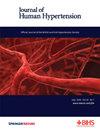Position statement on hypertension by Indian Society of Hypertension, 2023
IF 2.7
4区 医学
Q2 PERIPHERAL VASCULAR DISEASE
引用次数: 0
Abstract
The Indian Society of Hypertension (InSH) highlights the urgency for India-specific guidelines on hypertension management. Hypertension affects over one billion people worldwide, with India bearing a significant burden due to its population, diversity, and demographics. In India, hypertension affects 21% of women and 24% of men, while pre-hypertension affects 39% of women and 49% of men. The prevalence of hypertension increases in the population with obesity. Even 7% of school-going children in India have hypertension, especially in urban and overweight children. However, awareness and control of hypertension in India are inadequate. Only 57% of women and 38% of men have been diagnosed with hypertension; among them, only a fraction receive appropriate medication. The overall control of hypertension stands at 15%, with regional variations. Hypertension significantly contributes to cardiovascular and renal diseases, and better detection and treatment could reduce their impact in India. At the total population level, reducing systolic blood pressure (SBP) by 2 mm Hg may significantly affect cardiovascular disease. Considering the unique challenges faced in India, the InSH stresses the importance of a tailored approach to hypertension management. They plan to disseminate guidelines through practitioner training and patient awareness campaigns. These guidelines will cover screening, diagnosis, management, handling hypertension with other conditions, long-term follow-up, and patient education. In conclusion, this position paper calls for immediate action to improve hypertension management in India and alleviate the associated disease burden and mortality.印度高血压学会关于高血压的立场声明,2023 年。
印度高血压学会(InSH)强调了制定针对印度的高血压管理指南的紧迫性。全世界有超过 10 亿人受到高血压的影响,印度因其人口、多样性和人口结构而承受着沉重的负担。在印度,21% 的女性和 24% 的男性患有高血压,39% 的女性和 49% 的男性患有高血压前期。高血压的发病率随着肥胖而增加。印度甚至有 7% 的在校儿童患有高血压,尤其是在城市和超重儿童中。然而,印度对高血压的认识和控制不足。只有 57% 的女性和 38% 的男性被诊断出患有高血压;其中只有一小部分人接受了适当的药物治疗。高血压的总体控制率为 15%,各地区之间存在差异。高血压是心血管疾病和肾脏疾病的重要诱因,更好的检测和治疗可以减少这些疾病对印度的影响。在总人口水平上,收缩压降低 2 毫米汞柱可能会对心血管疾病产生重大影响。考虑到印度面临的独特挑战,印度高血压学会强调了因地制宜的高血压管理方法的重要性。他们计划通过从业人员培训和提高患者认识的活动来传播指导方针。这些指南将涵盖筛查、诊断、管理、处理高血压与其他疾病、长期随访和患者教育。总之,这份立场文件呼吁立即采取行动,改善印度的高血压管理,减轻相关疾病负担,降低死亡率。
本文章由计算机程序翻译,如有差异,请以英文原文为准。
求助全文
约1分钟内获得全文
求助全文
来源期刊

Journal of Human Hypertension
医学-外周血管病
CiteScore
5.20
自引率
3.70%
发文量
126
审稿时长
6-12 weeks
期刊介绍:
Journal of Human Hypertension is published monthly and is of interest to health care professionals who deal with hypertension (specialists, internists, primary care physicians) and public health workers. We believe that our patients benefit from robust scientific data that are based on well conducted clinical trials. We also believe that basic sciences are the foundations on which we build our knowledge of clinical conditions and their management. Towards this end, although we are primarily a clinical based journal, we also welcome suitable basic sciences studies that promote our understanding of human hypertension.
The journal aims to perform the dual role of increasing knowledge in the field of high blood pressure as well as improving the standard of care of patients. The editors will consider for publication all suitable papers dealing directly or indirectly with clinical aspects of hypertension, including but not limited to epidemiology, pathophysiology, therapeutics and basic sciences involving human subjects or tissues. We also consider papers from all specialties such as ophthalmology, cardiology, nephrology, obstetrics and stroke medicine that deal with the various aspects of hypertension and its complications.
 求助内容:
求助内容: 应助结果提醒方式:
应助结果提醒方式:


